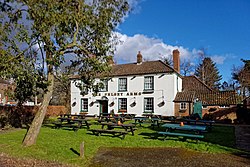Coolham
| Coolham | |
| Sussex | |
|---|---|
 Selsey Arms, Coolham | |
| Location | |
| Grid reference: | TQ120227 |
| Location: | 50°59’36"N, 0°24’19"W |
| Data | |
| Post town: | Horsham |
| Postcode: | RH13 |
| Local Government | |
| Council: | Horsham |
| Parliamentary constituency: |
Horsham |
Coolham is a small village in the north of Sussex, sitting at the crossroads of the A272 and B2139 roads, three miles south-east of Billingshurst.
At the crossroads is an old timber-framed inn, the Selsey Arms, formerly the Duke's Head, and before that The King of Prussia.
During the Second World War there was an Advanced Landing Ground nearby called RAF Coolham, used to support the D-Day landings.[1][2] This was only in use for about eighteen months, and had almost no permanent buildings. The airmen lived under canvas. Both Polish and British airmen were stationed there, and there is a monument outside the Selsey Arms that lists the names of those who died. The land has long since been reclaimed for agricultural purposes, but there is still a footpath around the field, with trees planted at intervals to commemorate the dead airmen. Each tree has a name plaque attached.
There was once a prominent Quaker community in Coolham, and the "Blue Idol" meeting house, a timber-framed building, still exists. William Penn, who earlier had founded Pennsylvania in America, was closely involved in its establishment, and is believed to have worshipped there. The local junior school was founded as the Coolham British School (later Coolham Primary School) in 1889 by the Quakers. In the mid-twentieth century it moved to its present site, where it is known as the William Penn Primary School.
Nearby is Knepp Castle, a mediaeval hunting lodge used by King John.[3]
Outside links
| ("Wikimedia Commons" has material about Coolham) |
References
- ↑ Birmingham Daily Gazette 1945 Retrieved 15 February 2018
- ↑ Winnipeg Free Press 1993 Retrieved 15 February 2018
- ↑ Turner, Edward (1870). "Steyning and West Grinstead Churches, and the Ancient Castle of Knepp". Sussex Archaeological Collections 22: 17-18. doi:10.5284/1085409.